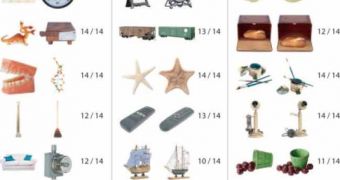Human memory has been previously tested, but not to the extent of this experiment developed and performed by people from MIT (Massachusetts Institute of Technology). They managed to prove that the 14 people involved in the test were able to remember specific details about almost 3.000 pictures they were presented.
In approximately 5 hours’ time, 14 tested people aged 18 to 40 watched about 3.000 images, one at a time, for 3 seconds each. Then they were presented image pairs and asked to identify the correct object, the one they had previously seen.
The scientists pushed the memory of the subjects to the limit. Previous tests, performed by a team from the University of Missouri capped the working memory ability of retaining items to an amount of four. We are talking about a type of short-term memory (used for temporary information storage) that allows us to pay attention and handle information. There are certain people who can fare even better (as in more than 4 items simultaneously), but they make use of all kinds of tricks for that, such as grouping or associations (for numbers or names, for example).
The scientific world is still divided in terms of correlations between working memory and the long-term one. While part of the scientists claim that they are independent from one another, the others state that the working memory is the part of long-term memory that we can access for current usage. Most researchers agree, though, when it comes to the fact that all memories are stored. After that, it's only a matter of being able to access them. Psychologist Nelson Cowan from the University of Missouri, who led the respective study, stated, “Everything gets encoded into long-term memory almost immediately, but it gets encoded in a way that may not be distinct enough to be retrieved”.
Both previous tests and the recent one came to the same conclusion according to which memory can be trained and improved.
The MIT study showed that human memory is far more capable than expected when the conditions for it to function at full capacity are met. One such condition that the study team addressed was choosing familiar, concrete objects for the pictures (bread, dollar bills, remote controls etc.) and not abstract ones. Also, another helping factor was considered to be motivation (the person who would give the most correct answers was promised a small amount of money). MIT test co-leader Talia Konkle argumented, "You have to try, you have to want to do it."
The results were completely astonishing. Not even the most optimistic of the test developers had anticipated them to be so positive. The test had 3 stages: after watching the 3.000 pictures, test subjects had to choose the correct items first from picture pairs of totally different items, secondly from a pair of images representing an item and a different example of the same item type (like 2 different watches) and thirdly from photos of an item and of another slightly modified instance of the same item (like a full cup and a half-full cup). 92% gave the correct answer in the first case, 88% in the second and 87% in the third stage.
Although 14 subjects may seem like a very small number for a test with such grand aims, the almost identical rates of success registered by each subject is a statement for its accuracy. Timothy Brady, cognitive neuroscientist at MIT told LiveScience, "To give just one example, this means that after having seen thousands of objects, subjects didn’t just remember which cabinet they had seen, but also that the cabinet door was slightly open." But this doesn't mean that we are not allowed to forget anymore. As LiveScience quotes him, "To some extent it's about attention, actively encoding specific details into memory. If we tried really hard we actually could remember when someone's birthday was: if you say to yourself, 'The birthday is on this day and that relates to these other things that I remember'."
This is the most relevant study so far in this regard. As Brady said, “People had never tested whether people could remember this much detail about this many objects. Nobody actually pushed it this far”. The experiment was funded by the National Science Foundation, a National Defense Science and Engineering Graduate Fellowship, National Institutes of Health and a National Research Service Award.

 14 DAY TRIAL //
14 DAY TRIAL //